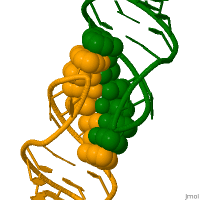

In genetics, a kissing stem-loop, or kissing stem loop interaction, is formed in ribonucleic acid (RNA) when two bases between two hairpin loops pair. These intra- and intermolecular kissing interactions are important in forming the tertiary or quaternary structure of many RNAs.[2]
RNA kissing interactions, also called loop-loop pseudoknots, occur when the unpaired nucleotides in one hairpin loop, base pair with the unpaired nucleotides in another hairpin loop.[3] When the hairpin loops are located on separate RNA molecules, their intermolecular interaction is called a kissing complex. These interactions generally form between stem-loops. However, stable complexes have been observed containing only two intermolecular Watson–Crick base pairs.[4][5]
- ^ Adapted from Proteopedia page.
- ^ Forsdyke DR (September 1995). "A stem-loop "kissing" model for the initiation of recombination and the origin of introns". Molecular Biology and Evolution. 12 (5): 949–958. doi:10.1093/oxfordjournals.molbev.a040273. PMID 7476142.
- ^ Nowakowski J, Tinoco Jr I (1997). "Semin". Virology. 8: 153–165. doi:10.1006/smvy.1997.0118.
- ^ Kim CH, Tinoco I (August 2000). "A retroviral RNA kissing complex containing only two G.C base pairs". Proceedings of the National Academy of Sciences of the United States of America. 97 (17): 9396–9401. doi:10.1073/pnas.170283697. PMC 16875. PMID 10931958.
- ^ Andersen AA, Collins RA (July 2001). "Intramolecular secondary structure rearrangement by the kissing interaction of the Neurospora VS ribozyme". Proceedings of the National Academy of Sciences of the United States of America. 98 (14): 7730–7735. Bibcode:2001PNAS...98.7730A. doi:10.1073/pnas.141039198. PMC 35410. PMID 11427714.